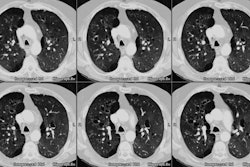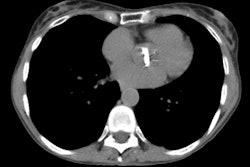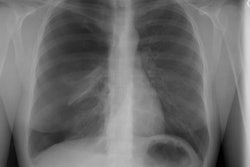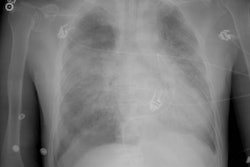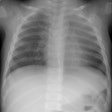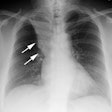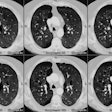J Thorac Imaging 1996;11(2):92-108. Types and mechanisms of pulmonary atelectasis.
Woodring JH, Reed JC
Atelectasis is one of the most commonly encountered abnormalities in chest radiology and remains a daily diagnostic challenge. At times atelectasis can be overlooked, particularly when pulmonary opacification is minimal or absent, and at other times it might be interpreted as being some other form of intrathoracic pathology, particularly pneumonia. The direct signs of atelectasis are crowded pulmonary vessels, crowded air bronchograms, and displacement of the interlobar fissures. Indirect signs of atelectasis are pulmonary opacification; elevation of the diaphragm; shift of the trachea, heart, and mediastinum; displacement of the hilus; compensatory hyperexpansion of the surrounding lung; approximation of the ribs; and shifting granulomas. For descriptive purposes, atelectasis can be divided into the following types: segmental, lobar, or whole lung; subsegmental; platelike, linear, or discoid; round; and generalized or diffuse. Resorption atelectasis is caused by resorption of alveolar air distal to obstructing lesions of the airways; adhesive atelectasis stems from surfactant deficiency; passive atelectasis is caused by simple pneumothorax, diaphragmatic dysfunction, or hypoventilation; compressive atelectasis is due to tension pneumothorax, space-occupying intrathoracic lesions, or abdominal distention; cicatrization atelectasis stems from pulmonary fibrosis; and gravity-dependent atelectasis is the result of gravity-dependent alterations in alveolar volume. Whenever signs of volume loss are present on a chest radiograph, the radiograph should be interpreted as showing atelectasis. By understanding the various mechanisms leading to atelectasis, and by considering the underlying conditions, the radiologist should be able to develop an appropriate list of the possible causes of atelectasis. The diagnosis of atelectatic pneumonia should be based upon the presence of clinical signs and symptoms of pneumonia coupled with the identification of pathogenic bacteria in sputum, tracheal aspirates, or protected bronchoalveolar lavage or bronchial brush specimens rather than on the radiographic identification of atelectasis alone.
PMID: 8820021, MUID: 96417230
